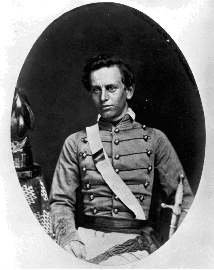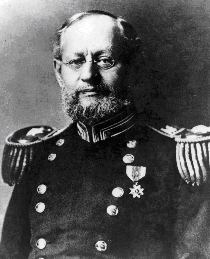|
Meetings can be lively, heated, even rancorous affairs, and church meetings, as anyone who has attended them can attest, are no exception. Twenty-five year old Army Engineer Henry Martyn Robert found this out while stationed in New Bedford, Massachusetts in 1862-63, recovering from a tropical fever he had contracted in Panama. A deeply religious Baptist, he was unexpectedly asked to chair a meeting of the local Baptist Church. The challenge proved formidable.
Robert graduated fourth in his class at West Point in 1857, where he returned as an instructor, and then supervised fortifications construction in the Northwest, and again, at the beginning of the Civil War, around Washington, D.C. In all his assignments he had shown himself to be a promising soldier, competent leader, and an outstanding engineer. Yet, at New Bedford, Robert lost control of the church meeting. He later wrote, "One can scarcely have had much experience in deliberative meetings of Christians without realizing that the best of men, having wills of their own, are liable to attempt to carry out their own views without paying sufficient respect to the rights of their opponents." Embarrassed, he sought guidance from existing manuals of parliamentary procedure and found them to be next to useless, even occasionally absurd.
|
|
 Lieutenant Henry M. Robert Lieutenant Henry M. Robert |
Robert set out to become a student of parliamentary procedure. While his initial idea may have been simply to develop procedures to save him from any further embarrassment, fate intervened. From 1867 to 1871, then Major Robert served as chief engineer of the Military Division of the Pacific and lived in San Francisco. There he served on the Board of Trustees of the First Baptist Church and also on the Board of Directors of the YMCA. Contentious issues confronted the parishioners: Should the pastor or the congregation approve new members? Should women be allowed to vote in business meetings? Should the church move to a more respectable part of town? The church's "Constitution and Rules of Order" that guided the conduct of business meetings was neither comprehensive nor precise; one of its instructions was to "love and be kind to one another." Unfortunately, such admonitions did not prevent rancor, and the ineptly drawn guidelines contributed to, rather than diminished, the acrimony.
Robert's experience with the YMCA was even more revealing. An interdenominational organization like the "Y" might have been especially susceptible to bickering; the records of the YMCA show that many disputes over procedural matters emerged during business meetings and the chair's authority was frequently challenged. Though many of the arguments were petty, Robert could not have helped but be further convinced of the need for some sort of parliamentary authority.
 Robert began writing a 16-page parliamentary guide for the societies that he and his wife had joined, but he soon decided that a generic guide for all organizations and associations was needed. His workload prevented him from pursuing this far more ambitious project with his transfer to Milwaukee in 1874. During a harsh winter that closed down the harbor, Robert drafted the first part of his manuscript. He finished the manuscript in 1875. After two unsuccessful attempts at getting it published, he went to a private printer in 1876 to have 4,000 copies printed at his expense. The 176-page Pocket Manual of Rules of Order for Deliberative Assemblies could be carried in a coat pocket, ready for easy reference. From that time on, Robert solicited letters and comments and, in response, revised his manual, with the most complete and important revision published in 1915, eight years before his death.
Robert began writing a 16-page parliamentary guide for the societies that he and his wife had joined, but he soon decided that a generic guide for all organizations and associations was needed. His workload prevented him from pursuing this far more ambitious project with his transfer to Milwaukee in 1874. During a harsh winter that closed down the harbor, Robert drafted the first part of his manuscript. He finished the manuscript in 1875. After two unsuccessful attempts at getting it published, he went to a private printer in 1876 to have 4,000 copies printed at his expense. The 176-page Pocket Manual of Rules of Order for Deliberative Assemblies could be carried in a coat pocket, ready for easy reference. From that time on, Robert solicited letters and comments and, in response, revised his manual, with the most complete and important revision published in 1915, eight years before his death.
The logic of Robert's Rules of Order, based on experience, not abstract law and custom, proved nearly irresistible. Its step by step system established a hierarchy of guiding principles that ensured order while protecting and advancing democratic principles. Other guides to parliamentary procedures fell into disuse by the beginning of the twentieth century, as his Rules of Order gained nearly universal favor.
|
As for Henry M. Robert, his professional life was long and distinguished. He served as superintending engineer on various parts of the Great Lakes and as engineer of the 4th and 13th lighthouse districts, as Engineer Commissioner in the District of Columbia, Nashville District Engineer, Division Engineer in the Northwest and Southwest Divisions, and finally, as Chief of Engineers at the end of his career. Following his retirement as a brigadier general, he chaired a board of engineers that designed the Galveston seawall following the disastrous hurricane of 1900.
Robert was a man of high moral character, religious conviction, and scientific commitment. His Rules of Order reflects these characteristics. He optimistically presumed that middle-class Christian virtue ensures the emergence of a worthy "general will" once members sliced through superficial procedural issues. Subsequent decades have severely challenged Robert's optimism. No doubt his manual will remain in the parliamentarian's coat pocket for a long time.
|
|
 |
| |
|
Brig. Gen. Henry M. Robert |
* * *
November 2001